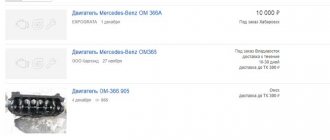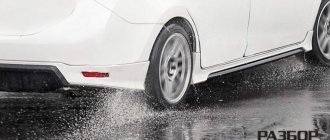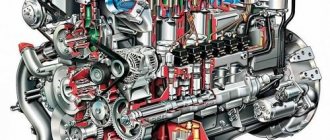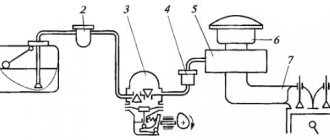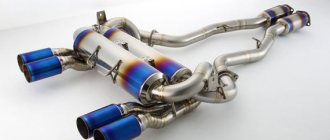Engine rear
CDI (Common Rail Diesel Injection System) is a series of diesel engines from the German manufacturer Daimler AG that were installed on Mercedes-Benz vehicles. Mercedes CDI engines were developed in 1997 and are successfully used to this day. These engines have direct fuel injection, which reduces fuel consumption by up to 15%. The manufacturer increased the engine torque and power by 40%.
The first model in the line was the Mercedes C 220 CDI with 125 hp. (92 kW) with a torque of 300 Nm at 1800 rpm! Making the Mercedes SDI engine with the most torque in its displacement class, setting new standards for fuel economy.
2006 also marked a major milestone for CDI when the Mercedes E 300 BLUETEC was voted "Global Green Car of the Year".
TDI engine
The abbreviation TDI is perhaps the most popular and easiest to decipher. The first letter “T” in this abbreviation denotes the presence of turbocharging, which allows you to get a serious increase in power. A turbo engine has all the properties inherent in turbocharged engines; it is more economical, has cleaner exhaust, and is more expensive to maintain. In addition, few people know that most turbines installed on turbo engines are designed for
150-200 thousand km. mileage, and this despite the fact that the engine itself, as a rule, is “millionaire”.
Common rail diesel injection
Injection timing and fuel quantity are calculated for each cylinder (similar to Motronic) and injected through fast-acting solenoid valves (injectors).
This technology reduces fuel consumption and reduces exhaust emissions.
Injection is divided into three groups:
- Pre-injection for quiet engine operation
- Main injection , for a good torque curve
- After injection for low NO x value.
Unlike pilot and main injection, the fuel is not burned in the post-injection, but is evaporated by residual heat in the cylinder. This rich fuel mixture of exhaust gases is fed during the exhaust stroke through the exhaust valves into the exhaust system.
Fault overview
Like all mechanical structures, CDI engines have malfunctions and childhood diseases that engineers gave them due to miscalculations. For example, on the 611 engine from Mercedes, due to its high efficiency, engine heating is low. Therefore, engineers additionally installed a liquid heater from WebAsto. Since in cold weather there were problems with starting the engine.
Attention! This model had a whole series of engines for Mercedes. For all engines, this disease was copied and not corrected.
Spark plugs are considered another malfunction of these engines. For example, they need to be unscrewed every 20 thousand kilometers and lubricated with thermal paste. Otherwise, after 100 thousand kilometers you will have to remove the cylinder head and drill out the spark plugs.
The crank mechanism also often fails. This happens for several reasons:
- low lubricant pressure. The motor pump may be faulty. Therefore, you should check it and replace it with a new one if it breaks;
- non-original oil was filled. The engine needs high-quality lubrication.
Crankshaft and camshaft sensors often fail. The injectors become clogged due to the fact that the car owner uses low-quality fuel. The pressure sensor in the fuel rail fails. And in winter, all elastic rubber seals crack and harden due to constant temperature changes. Therefore, it is advisable to replace them in the spring and carry out complete preventative work on the engine only in the spring.
In addition to the main problems listed, the car owner may encounter less frequent malfunctions of this engine. Replacement equipment is expensive, so it is best to keep an eye on the motor and prevent it from breaking down. Feed only high-quality gasoline and oil.
Popular CDI diesel engines
Engine OM611 cdi
1998-2004
These are four-cylinder diesel engines of 2.1 and 2.2 liters. Buyers are offered versions of different power: 81, 101, 108, 114, 120, 127, 134 and 141 hp.
The OM611 engine was installed on the Mercedes-Benz Sprinter (W90x), Mercedes-Benz E-Class (W210), Mercedes-Benz C-Class (W203), Mercedes 220 cdi engine.
Engine OM668 1.7 cdi
1998-2005
These diesel engines have four cylinders and a displacement of 1.7 and 2.7 liters. The following cars are available for sale with the OM668 engine: Mercedes-Benz A-Class (W168), Mercedes-Benz A-Class (W169) and Mercedes-Benz Vaneo (W414).
Engine OM612 cdi
1999-2006
Unlike the previous generation, the cdi OM612 diesel engine had five cylinders. The volume was 2.7 liters. Power varied from 154 to 170 hp, and torque - from 330 to 370 N-meters. The engine was installed on Mercedes-Benz Sprinter (W90x), Mercedes-Benz C-Class (W203), Mercedes-Benz E-Class (W210).
Engine OM613 cdi
1999-2003
The engine had 6 cylinders, the volume is 3.2 liters and the power reaches 197 hp. With. This engine was installed on the Mercedes-Benz S-Class (W220).
Engine OM628 cdi
1999-2010
It was the first V-twin engine in the CDI series. It had 8 cylinders and a volume of 4 liters, a torque of 560 Nm, and a power of 250 hp. Installed on Mercedes-Benz E-Class (W211), Mercedes-Benz S-Class (W220), 220 cdi engine, Mercedes-Benz M-Class (W163), Mercedes-Benz G-Class (W463).
Engine OM647 cdi
2002-2006
Five-cylinder, 2.7-liter unit with a power of 177 hp. Torque 400 N - m. Installed on the Mercedes-Benz E-Class sedan (W211).
Engine OM648 cdi
2002-2005
This is a 6 cylinder engine. The engine capacity is 3.2 liters. The engine had two versions of different power. Engines with power of 177 and 204 hp. often installed on models such as Mercedes-Benz E-Class (W211), w211 cdi engines and Mercedes-Benz E-Class (W220).
Engine OM646 cdi
2003-2010
It is a 2.2 liter inline 4 cylinder engine with a turbocharger, cast iron cylinder block and aluminum head. Power varied from 88 to 170 hp. In 2006, the second generation appeared - OM646 EVO. Engineers made more than 90 changes to the engine design. These models were equipped with the OM646 engine: Mercedes-Benz Vito (W639), Mercedes-Benz Sprinter (W906), Mercedes-Benz C-Class (W203), 2.2 cdi engine, Mercedes-Benz C-Class (W204), Mercedes -Benz CLK-Class (W209), glk 220 cdi engine and Mercedes-Benz E-Class (W211).
Engine OM629 4.0 cdi
2005-2011
This engine was a slightly modified version of the OM628. A characteristic feature was increased power and torque. In addition to its predecessor, the OM629-V8 engine has a capacity of 4 liters. Power ranged from 306 to 320 hp. s., and the torque is from 700 to 730 N.m. The engine was developed for the Mercedes-Benz M-Class (W164), Mercedes-Benz GL-Class (X164), Mercedes-Benz E-Class (W211) and Mercedes-Benz S-Class (W221).
Engine OM651 cdi
2008 - until today
It is a 4-cylinder in-line engine with a turbocharger. Power: 1.8 and 2.2 l, power: 95 - 204 hp. The engine block is made of gray cast iron. Installed on these models: Mercedes-Benz A-Class (W176), Mercedes-Benz B-Class (W246), Mercedes-Benz CLA (C117), Mercedes-Benz Sprinter (W906), Mercedes-Benz C-Class (W204) , Mercedes-Benz-Blass (W206), Mercedes-Benz C-Class (W205), Mercedes-Benz Vito, Mercedes-Benz E-Class (W212), Mercedes Vito cdi engine, Mercedes-Benz Viano / Vito (W639), Mercedes-Benz GLK (X204), Mercedes-Benz M-Class (W166), Mercedes-Benz SLK (R172), Mercedes-Benz GLC (X253), Mercedes-Benz M-Class (X253) and Mercedes-Benz.
Mercedes-Benz Vito 109 CDI
Mercedes-Benz Vito 109 CDI
Mercedes-Benz Vito 109 CDI
PRIVILEGES - NOT FOR THE DRIVER
This business trip to St. Petersburg could have been postponed, but having learned that they were offering to go in a Vito, I agreed without hesitation: fifteen hundred kilometers behind the wheel is an excellent opportunity to get to know the car properly. At one time, my friend for ten years faithfully served the MV 100D, from the front it looked like a Rubin TV with wheels. One of its advantages was front-wheel drive - previously simply impossible for this brand and then a rare design solution for Mercedes. But the Vito, produced since 2004 at the same concern plant in the Spanish city of Vitoria, has acquired a classic layout - with rear wheel drive. And I was very interested in comparing the current Vito with its predecessors, and at the same time understanding the design features of the small van.
The current Vito is not only prettier than the previous one, but also longer: the wheelbase is 3200 mm, and there is also an enlarged one - 3430 mm. The rear overhang also has variations: regular and extended differ by 245 mm. Moreover, the van is lengthened not by the primitive insertion of an extra window section, but by rear side panels (in three versions) welded behind the sliding door. The roof height is also optional: from floor to ceiling 1350 or 1760 mm. Accordingly, the volume of the “micro truck” is from 4.65 to 6.49 cubic meters with a load capacity of 930 to 1150 kg. However, the long-wheelbase modification does not have an option with a high roof - then the volume would be even greater. My car has a wheelbase of 3200 mm, low, with a long rear overhang.
What is a CDI engine and why is it good?
Interest in diesel engines and cars using them as power units is traditionally high in our country. One of the most attractive engines today is CDI (Common rail Diesel Injection) , produced by the Mercedes automaker. Let's take a closer look at what a CDI engine is and why it is good for Russian operating conditions.
Features of operating a CDI engine
As mentioned above, the CDI motor is tough, durable, and economical, but its repair is extremely expensive. The reason for this is the need to purchase original spare parts, which are manufactured using patented technology that ensures the necessary strength of the metal. In order not to accelerate the wear of individual parts and to avoid unnecessary repairs, it is necessary to pay attention to the following points.
Compared to earlier models, the CDI engine shows significantly improved performance results. But any equipment lasts a long time only with high-quality care and timely preventive maintenance, which is preferably carried out at a company service center.
Source
Mercedes cdi engine: what is it and explanation
The CDI engine from Mercedes is considered the most economical engine among other diesel engines. This is because the name already contains the name of the innovative injection system, with the help of which gasoline consumption has become low. At the same time, the company increased its capacity by almost half.
Let's see what a CDI engine is and how it differs from its brothers TDI and HDI.
Design Features
Many car owners ask us experienced mechanics what CDI means. In fact, the decoding of the name of the Mercedes engine is simple: Common rail Diesel injection. This is the name of the injection system in new diesel units.
Let's take a closer look at this technology to find out what it is.
Attention! This type of motor is also called a nameplate motor.
CDInjection is a technology that directly injects fuel directly into the combustion chamber. The direct injection system without pre-injection was developed in 1993 by Bosch. And this system, together with preliminary injection, began to be installed on Mercedes engines only in 2001.
This happens as follows:
What else allowed this system to take a leading place:
Pre-injection allows the main injection to already enter the heated chamber. This increases the rate of ignition. This means engine detonation and fuel consumption are reduced.
Related article Beams 1G FE Engine Specifications
Engines with this injection system are much more expensive to maintain and repair than conventional ones. But they are reliable and capable of covering more than 500 thousand kilometers. However, they are demanding on fuel quality. Less than AI95 should not be poured into such motors. Otherwise, it will fail in the first two years.
TDI and HDI have the same injection system, but with slight differences. TDI is a turbocharged engine. At the same time, HDI are considered the most durable in this line.
CDI Specifications
This is a whole series of engines that were installed on various Mercedes vehicles. The table shows information about one of the Mercedes CDI engines.
| CDI engine parameter | Meaning |
| Type | Diesel |
| Engine volume | 2.8 l |
| Power | 177 horses |
| Torque | 400 Nm |
| Location | Longitudinal under the hood at the front |
| Injection system | Common Rail |
| Location of valves and camshaft | Overhead valve |
| Fuel consumption | 9.3 l in the city 6.7 l on the highway |
| Fuel type | Diesel |
| Number of valves in 1 cylinder | 4 |
Despite the great advantages that were given to the engine with the Common Rail Injection system, many car owners and experienced mechanics do not like this engine. This is due to the high cost of parts. Such CDI engines will run smoothly only with original spare parts.
Now let's look at the modifications of vehicles on which these CDI engines can be seen:
Each model has a CDI prefix. A Mercedes pre-injection engine must be brought in for preventative maintenance every year. It should not be overheated.
cdi service regulations
Such CDI type engines must be serviced from time to time, no more than after 365 days. Any delay will be a step towards a major overhaul for CDI. It is advisable to change the air filter and oil filter every 40 thousand kilometers. Moreover, if the car owner cannot make a replacement on his own, then it is better to contact good service workshops. Along with the oil filter, the engine lubricant also changes.
Similar article Technical characteristics of the VAZ 21213 engine
The oil itself is changed every 10 thousand kilometers. In northern regions, it is advisable to use 5 W30, which can withstand low temperatures and not turn into a viscous mass.
These CDI engines run only on high-quality fuel. Dilute diesel with paraffin will destroy the entire structure. Annual cleaning of the radiator cooling system is mandatory. You will need to remove the radiator yourself and wash it.
Another problem is the CDI engine injectors. Experienced mechanics recommend diagnosing them every 100 thousand kilometers. After diagnostics, replace the bolts, because the latter become unusable.
Proper care will allow these CDI engines to work for the owner for many years.
Fault overview
Like all mechanical structures, CDI engines have malfunctions and childhood diseases that engineers gave them due to miscalculations. For example, on the 611 engine from Mercedes, due to its high efficiency, engine heating is low. Therefore, engineers additionally installed a liquid heater from WebAsto. Since in cold weather there were problems with starting the engine.
Attention! This model had a whole series of engines for Mercedes. For all engines, this disease was copied and not corrected.
Spark plugs are considered another malfunction of these engines. For example, they need to be unscrewed every 20 thousand kilometers and lubricated with thermal paste. Otherwise, after 100 thousand kilometers you will have to remove the cylinder head and drill out the spark plugs.
The crank mechanism also often fails. This happens for several reasons:
Crankshaft and camshaft sensors often fail. The injectors become clogged due to the fact that the car owner uses low-quality fuel. The pressure sensor in the fuel rail fails. And in winter, all elastic rubber seals crack and harden due to constant temperature changes. Therefore, it is advisable to replace them in the spring and carry out complete preventative work on the engine only in the spring.
